Why does it look like some of your chickens don’t molt at all, while others are nearly bald during molting season?
Don’t worry—while it may appear that only a few ladies from your flock are molting in summer and fall, they all go through normal, healthy cycles that take anywhere from as little as one month to as long as five months.
Read more: What Happens When a Chicken Molts (A Visual Guide)
Here’s a look at why some of your chickens seem to be speedy molters, while others go through a full molt very slowly.
Speedy molters
The main factor that determines the length of time for old feathers to shed and new feathers to grow is the particular breed of chicken.
Your most productive layers will molt the fastest.
They go through hard molts, whereby clutches of feathers seemingly drop overnight. It’s sometimes hard to believe that big old pile of feathers came from only one chicken! (And even harder to believe that the average adult chicken has around 8,000 feathers… that’s a lot of energy going into regrowing her coat.)
Hard molters can resemble porcupines (hilariously so!) and while their appearance is a little unsightly at this stage, they usually have fluffy new coats within weeks of their first feather drop. (And that’s a good thing, as the feathers help with insulation and weatherproofing over winter.)
Hard molters generally resume egg production after finishing their molts, which explains why certain chickens continue laying through the dark days of winter.
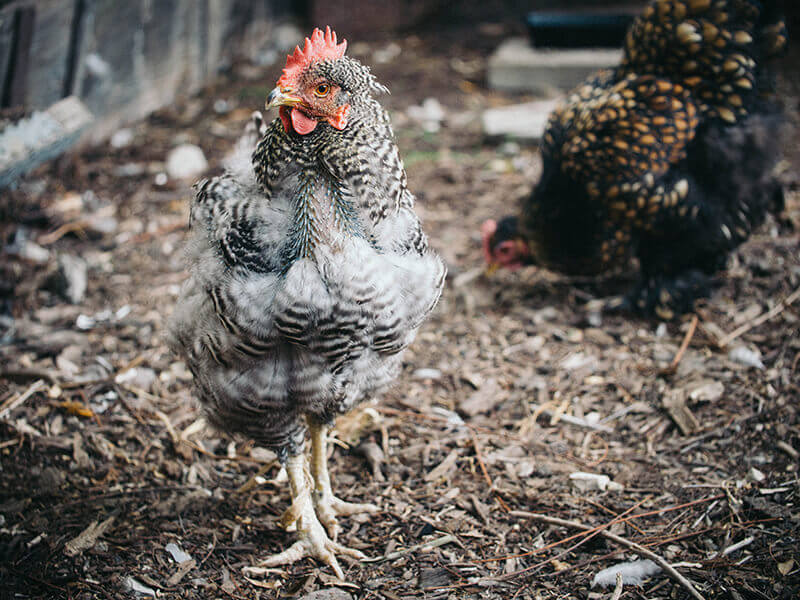
Slow molters
Your poorest layers, on the other hand, will molt the slowest.
They typically go through soft molts, shedding only a few feathers here and there. You may not even notice they’ve begun to molt, but you’ll definitely notice they’ve ceased their egg laying. Their molts may spread out over five or more months, meaning they usually won’t lay again until spring.
There’s nothing you can do to speed up the process, but even these soft molters benefit from a little extra protein during their long cycles to help them stay healthy.
It’s been shown that molts progress in a predictable pattern from top to tail. A lot of times this is true, but it isn’t always the case.
Don’t be alarmed if you notice your chicken losing her tail feathers first, or if she appears to be dropping feathers in a haphazard fashion all over her body.
Every chicken experiences a molt differently, even from year to year. And sometimes, environmental factors such as heat stress, malnutrition, or dehydration can cause molting out of season, or for longer than normal.
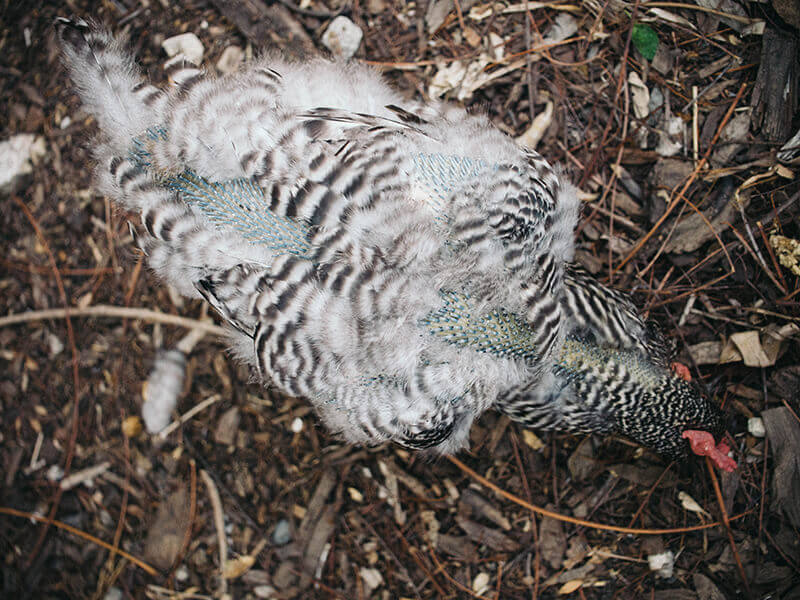
My experience with molting chickens
With my own flock, my Barred Rock, Kimora, is a prolific layer. She gives us five, sometimes six eggs a week in peak season, and she’s a fast and furious molter in the fall.
By week seven, all her new feathers are fully grown in and she’ll gift us with a couple of eggs each week over winter.
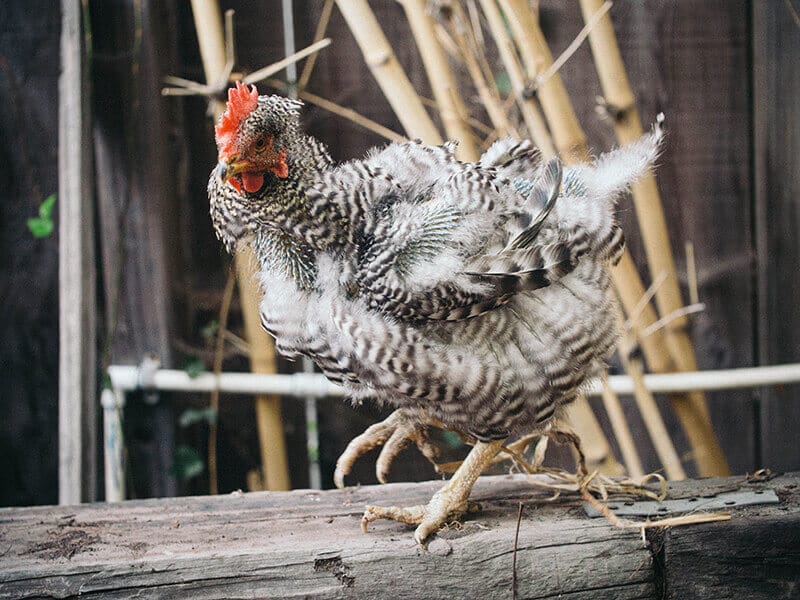
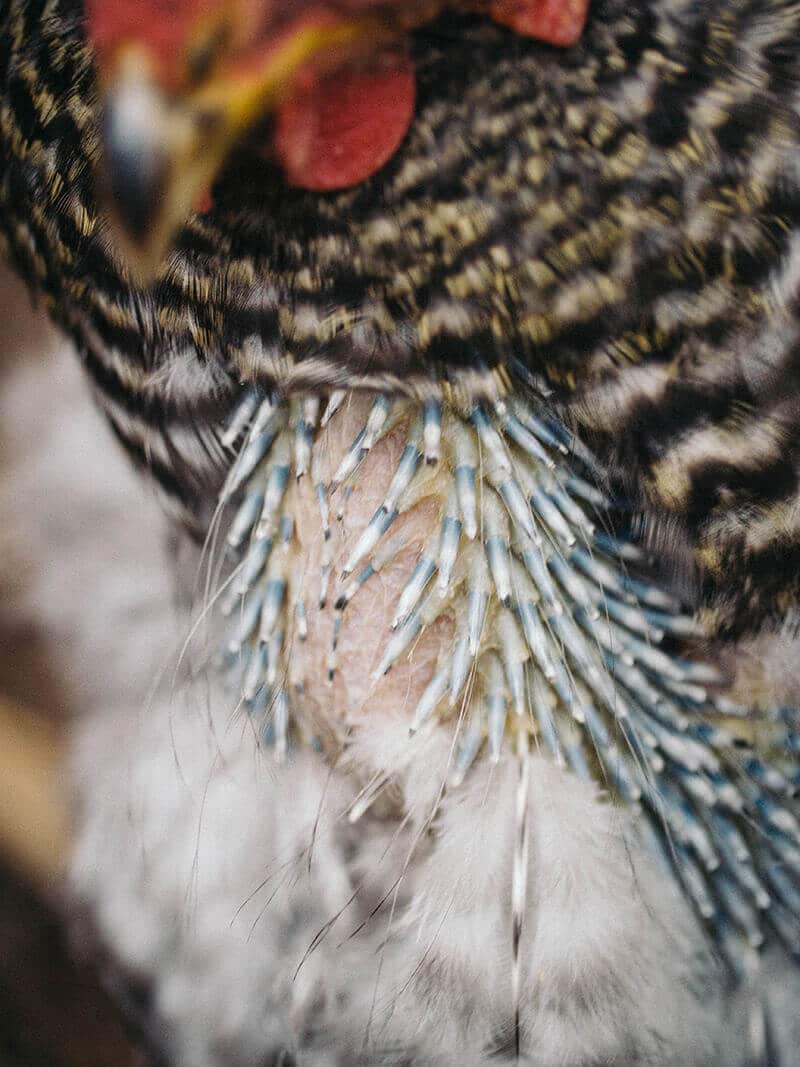
My Golden Laced Cochin, Iman, likes to take her sweet time. Cochins are not known for being super productive, but they’re always reliable. In summer, she lays around three eggs a week, and we cherish every one of them!
She usually starts molting in late summer to early fall and I only notice it after I find a few feathers in the coop—feathers, but not eggs. This continues until late winter when she finally pops out her first egg after a long hiatus.
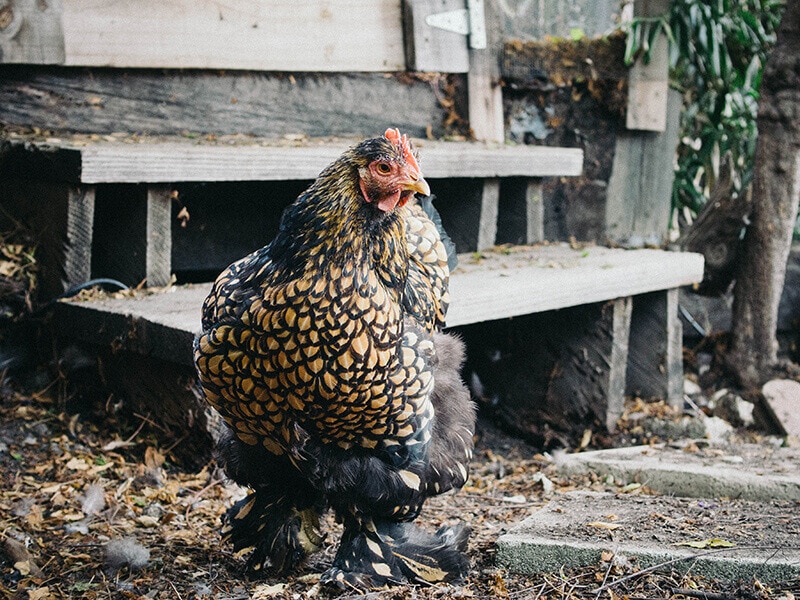
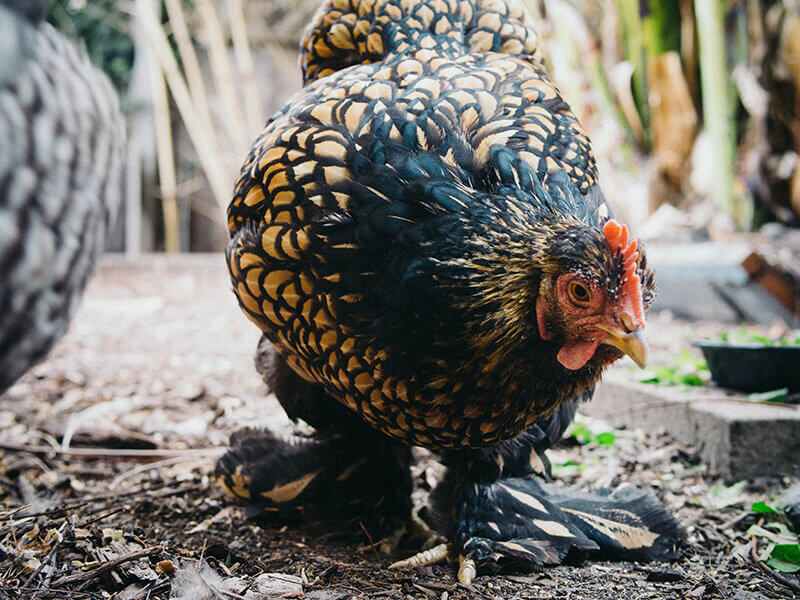
But this girl… what she lacks in egg productivity, she makes up for in lookin’ good year-round.
Common questions about molting
Do chickens molt their first year?
Chickens typically go through their first adult molt at 16 to 18 months old, and the molts occur every year in late summer to fall.
Younger hens (less than 12 months old) usually won’t molt in their first year, but will start molting the following year.
Keep in mind that the adult molt is different from the juvenile molts that happen when they’re just 1 week old (where they replace their downy covering with actual feathers), and again when they’re 8 to 12 weeks old (where they lose their “baby feathers” and grow a new set of adult feathers).
What naturally triggers chickens to molt?
Chickens have an internal clock (a circadian clock) that falls in rhythm with the amount and intensity of light present in any given season. When a chicken’s circadian clock senses a change in seasons (whether it’s from summer to fall, or from the dry to rainy season), it triggers the drop (and regrowth) of feathers in a process known as molting.
However, certain environmental factors like artificial lighting, heat stress, physical stress, malnutrition, and dehydration can also trigger chickens to molt out of season.
How long does a chicken molt last?
A chicken molt can last anywhere from one to five months and be considered normal and healthy. Some chickens may even take as long as six months to complete their molts, losing feathers slowly but consistently while growing in new ones.
But on average, you can expect your chickens to molt for about two months, beginning in late summer.
How can I speed up my chickens molting?
While there’s no way to speed up the complex process of molting, there are several ways you can supplement your chickens’ diet to help them stay healthy while growing back their feathers.
Chickens need extra protein during their molts, since feathers are composed primarily of protein. You can mix in a little bit of high-protein chick feed with their regular layer feed, give them extra mealworms and grubs as a treat, or let them free-range so they can forage their own bugs.
If you have any extras to spare, you can even feed scrambled eggs back to them (and no, it won’t encourage them to eat their own eggs later).
This post updated from an article that originally appeared on December 3, 2015.


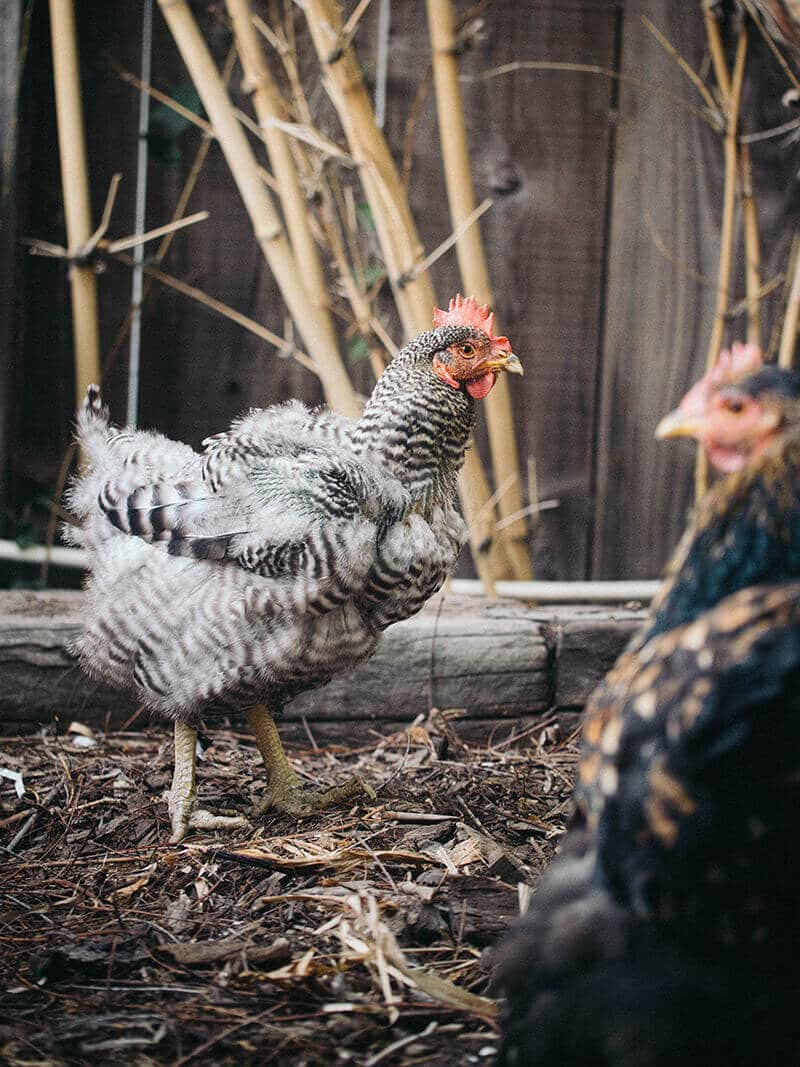













We clipped our Golden Comets’ wings about three years ago and they are still clipped. We haven’t observed any molting in GC’s, Leghorns, Australorps, or NH/RI Reds. It’s very strange. My chicks are full-time free-rangers in the woods and pastures (except for night time in the coop). Any thoughts on why they don’t molt? May be their molting is just occasional loosing and regrowing a feather here and there?
My chickens lay pretty much on a daily schedule all winter long. It gets pretty cold here in KY in February and March. But then, they stop laying for a month-and-a-half in the middle of the summer heat. The amount of light doesn’t seem to effect their laying abilities. I started using scheduled lighting in their coop this year, but it doesn’t seem necessary. Light is mostly for the convenience of climbing on their roost at night.
Kimberly
All chickens go through annual molts as part of their natural cycles, but perhaps yours just aren’t that noticeable (soft molts). They also don’t molt all at the same time; some start in summer while others wait until winter. If you’re adding artificial light in winter, this can throw off their circadian rhythms so they may not molt with the reduced daylight (instead waiting until it’s very cold, which can sometimes be problematic if you have very harsh winters). Eventually, their bodies will tell them to drop their feathers at some point in the year, whether all at once or bit by bit.
Merry King liked this on Facebook.
Your flock’s laying habits in winter are related to their molting habits. Why Some Chickens Molt Faster Than Others https://t.co/Q029zoX2nQ
If you’ve ever wondered why only half your flock is bald… Why Some Chickens Molt Faster Than Others https://t.co/FyqpW6VAji #gardenchat
Broderick Proeger liked this on Facebook.
Pillow fights in the coop? Why Some Chickens Molt Faster Than Others https://t.co/wzAZZlbACi #backyardchickens https://t.co/JyCfx1lRhA
Your best layers shed feathers the quickest (and other fun facts). Why Some Chickens Molt Faster Than Others https://t.co/IV2TIW4Wm6
Lauren Hayes liked this on Facebook.
Steve Herr liked this on Facebook.
Nancy Jacques Barratt liked this on Facebook.
Lauren Parnass liked this on Facebook.
Maria Grace liked this on Facebook.
Holly Curl German liked this on Facebook.
Beth Pappadopoulas Abate liked this on Facebook.
Will Taylor liked this on Facebook.
Greg Hadel liked this on Facebook.
I’ve been cheating on my chickens… by buying eggs from the store. I can’t wait for Kimora to start laying again this winter!
Jennifer Dendinger Crandall liked this on Facebook.
Jen Foerster Edwards liked this on Facebook.
Is some of your flock bald this season? Why Some Chickens Molt Faster Than Others https://t.co/1ubhgyY2iG #poultry https://t.co/lDKpo3Ajee
Congrats on your Sprout!!!!!!
I thought I was going to avoid the molt this year as I have two Feb-born girls, and two 3-year olds who apparently weren’t going to molt this year, going thru a huge molt last year! Ha. Now that we’re in the teens temperatures, they’ve started to drop feathers like crazy, all four of them.
And one of the older ones (a GLW, too, but no feathery feet) has even gotten a little pale and lost a little weight. She gets about 3 more days to pink up again or we’re heading into the avian vet (that $64 visit sure screws with egg prices, eh?).
I actually had to turn on the heat lamp in the run for them it got so cold here in CO last week. They quite liked it, choosing to roost in the run rather than their normally cozy but not heated sleeping coop. Then I turn off the light due to warmer temps and what do i find last night? They’re STILL roosting in the run. Tonight I’m moving them in to the coop to reestablish that habit!
Thank you!
As for your hens, it’s normal for their combs and wattles to pale during molting, and if you notice they’re not eating as much, it’s likely a sign to give them an extra boost of protein in their feed. I give mine scrambled eggs and other high-protein snacks to help with new feather growth.
oh gosh they love scrambled eggs! I’ve been giving them that just to give them something warm on these frigid mornings. Also, I found a feed called Feather Fixer by Nutrena, I believe, that’s 16% protein. And they LOVE it! Plus their mealworms/soldier fly larva/boss. It’s amazing they’re laying ANY eggs (i get one a day maybe) with all the protein/fat treats I’m giving them! But it’s about staying warm and growing feathers, not laying eggs right now! Oh, to be in Hawaii with chickens.
Laurie Smith liked this on Facebook.
Stacy McIntosh Davis liked this on Facebook.
Neligh Ust liked this on Facebook.
Sarah Ann Barnard liked this on Facebook.
Donna Peck liked this on Facebook.
Alterural liked this on Facebook.
Lydia Ann liked this on Facebook.
Blogged on Garden Betty: Why Some Chickens Molt Faster Than Others https://t.co/28Eh9ZXLxZ